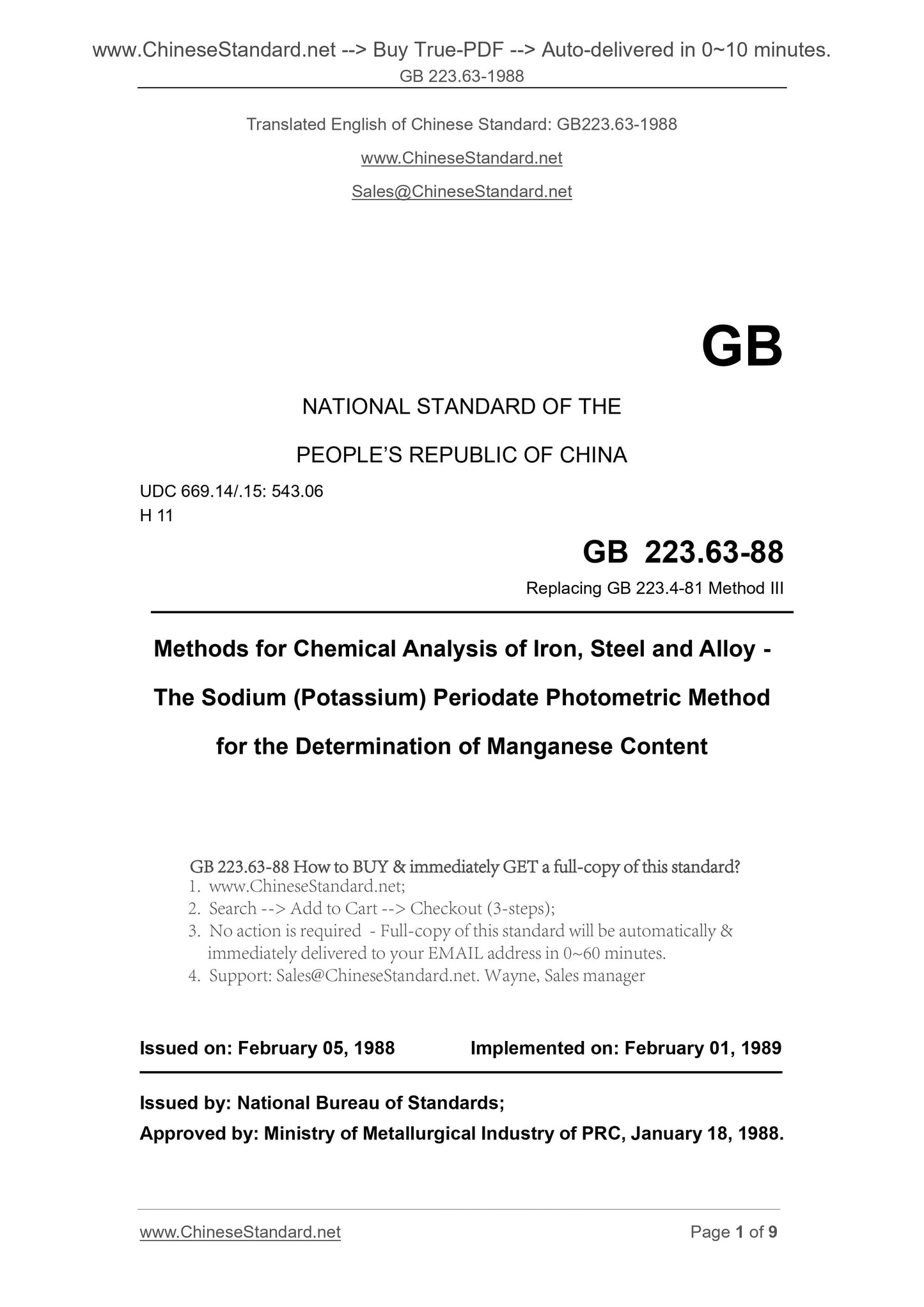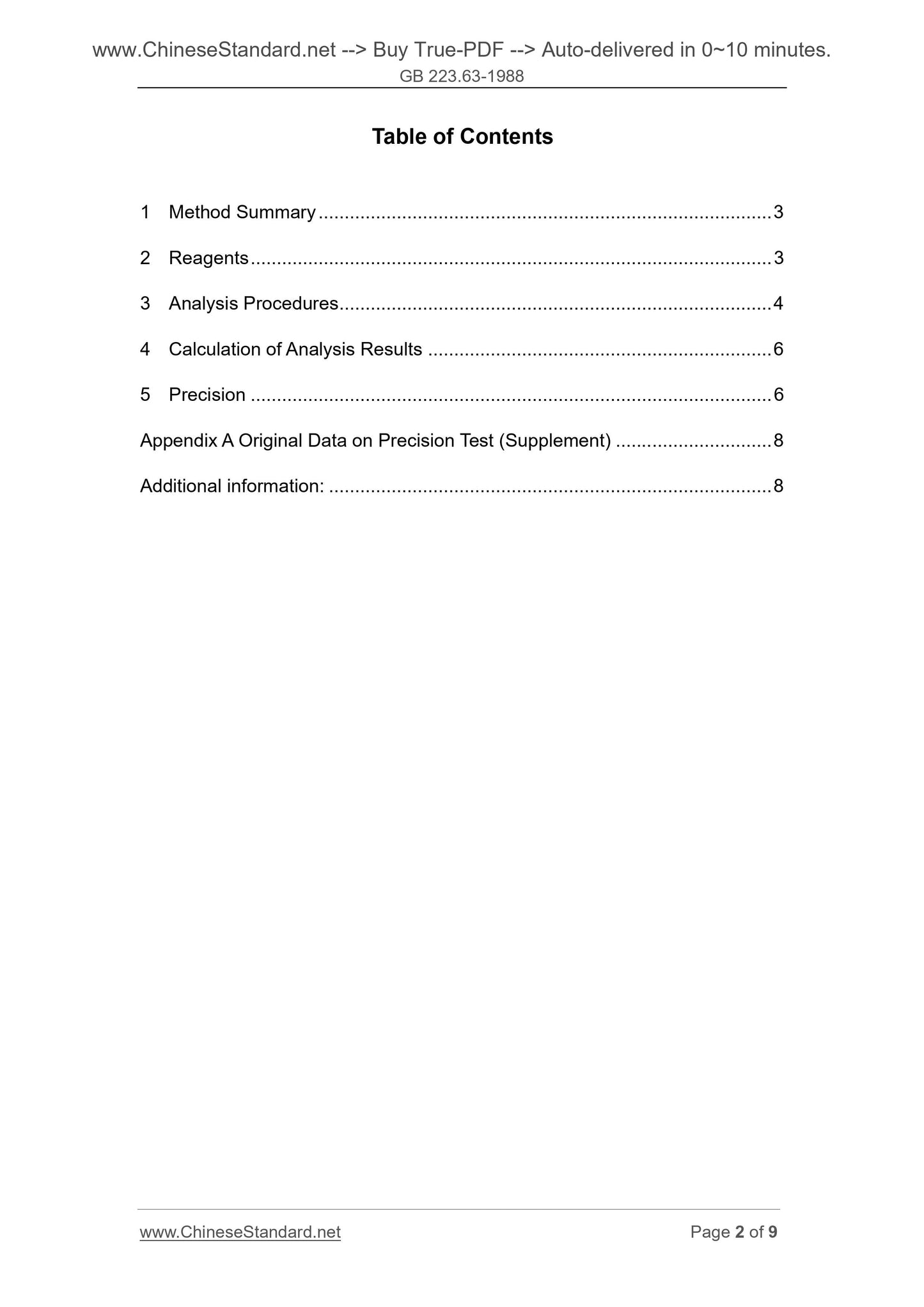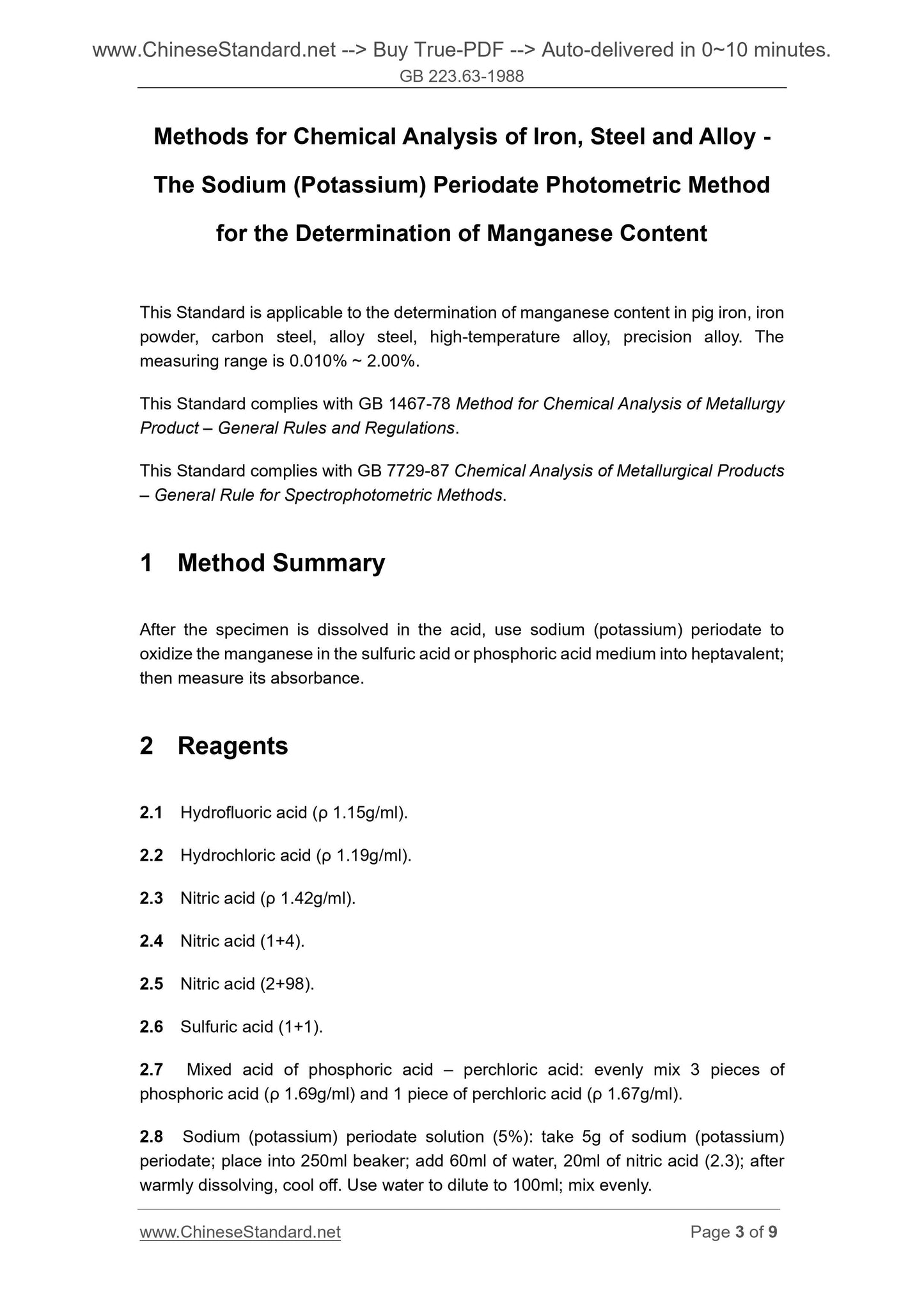1
/
of
3
PayPal, credit cards. Download editable-PDF and invoice in 1 second!
GB/T 223.63-1988 English PDF (GBT223.63-1988)
GB/T 223.63-1988 English PDF (GBT223.63-1988)
Regular price
$85.00 USD
Regular price
Sale price
$85.00 USD
Unit price
/
per
Shipping calculated at checkout.
Couldn't load pickup availability
Delivery: 3 seconds. Download true-PDF + Invoice.Newer version: (Replacing this standard) GB/T 223.63-2022
Get QUOTATION in 1-minute: Click GB/T 223.63-1988
Historical versions: GB/T 223.63-1988
Preview True-PDF (Reload/Scroll if blank)
GB/T 223.63-1988: Methods for chemical analysis of iron, steel and alloy - The sodium (potassium) periodate photometric method for the determination of manganese content
GB 223.63-1988
GB
NATIONAL STANDARD OF THE
PEOPLE’S REPUBLIC OF CHINA
UDC 669.14/.15. 543.06
H 11
GB 223.63-88
Replacing GB 223.4-81 Method III
Methods for Chemical Analysis of Iron, Steel and Alloy -
The Sodium (Potassium) Periodate Photometric Method
for the Determination of Manganese Content
ISSUED ON. FEBRUARY 05, 1988
IMPLEMENTED ON. FEBRUARY 01, 1989
Issued by. National Bureau of Standards;
Approved by. Ministry of Metallurgical Industry of PRC, January 18, 1988.
Table of Contents
1 Method Summary ... 3
2 Reagents ... 3
3 Analysis Procedures ... 4
4 Calculation of Analysis Results ... 6
5 Precision ... 6
Appendix A Original Data on Precision Test (Supplement) ... 8
Additional information... 8
Methods for Chemical Analysis of Iron, Steel and Alloy -
The Sodium (Potassium) Periodate Photometric Method
for the Determination of Manganese Content
This Standard is applicable to the determination of manganese content in pig iron, iron
powder, carbon steel, alloy steel, high-temperature alloy, precision alloy. The
measuring range is 0.010% ~ 2.00%.
This Standard complies with GB 1467-78 Method for Chemical Analysis of Metallurgy
Product – General Rules and Regulations.
This Standard complies with GB 7729-87 Chemical Analysis of Metallurgical Products
– General Rule for Spectrophotometric Methods.
1 Method Summary
After the specimen is dissolved in the acid, use sodium (potassium) periodate to
oxidize the manganese in the sulfuric acid or phosphoric acid medium into heptavalent;
then measure its absorbance.
2 Reagents
2.1 Hydrofluoric acid (ρ 1.15g/ml).
2.2 Hydrochloric acid (ρ 1.19g/ml).
2.3 Nitric acid (ρ 1.42g/ml).
2.4 Nitric acid (1+4).
2.5 Nitric acid (2+98).
2.6 Sulfuric acid (1+1).
2.7 Mixed acid of phosphoric acid – perchloric acid. evenly mix 3 pieces of
phosphoric acid (ρ 1.69g/ml) and 1 piece of perchloric acid (ρ 1.67g/ml).
2.8 Sodium (potassium) periodate solution (5%). take 5g of sodium (potassium)
periodate; place into 250ml beaker; add 60ml of water, 20ml of nitric acid (2.3); after
warmly dissolving, cool off. Use water to dilute to 100ml; mix evenly.
2.9 Sodium nitrite solution (1%).
2.10 Standard manganese solution
2.10.1 Take 1.4383g of reference potassium permanganate; place into 600ml beaker;
add 300ml of water to dissolve; add 10ml of sulfuric acid (2.6), titrate hydrogen
peroxide (ρ 1.10g/ml) till the red just fades; heating and boiling for 5~10min; cool off.
Transfer into 1000ml volumetric flask; use water to dilute to the scale; mix evenly. 1ml
of such solution contains 500µg of manganese.
It can also take 0.5000g of electrolytic manganese (99.9% above) [the electrolytic
manganese shall be pre-cleaned in sulfuric acid (5+95), after the manganese oxide on
the surface is removed, take out; immediately use distilled water to wash repeatedly;
then place into anhydrous ethanol to wash for 4~5 times; take out to place into the
dryer; it can be used after drying], place into 250ml beaker; add 20ml nitric acid (1+3);
heat and dissolve; boiling to expel the nitrogen oxide; take off, cool off to the room
temperature; transfer into 1000ml volumetric flask; use water to dilute to the scale, mix
evenly. 1ml of such solution contains 500µg of manganese.
2.10.2 Take 20.00ml of standard manganese solution (2.10.1); place into 100ml
volumetric flask; use water to dilute to the scale, mix evenly. 1ml of such solution
contains 100µg of manganese.
2.11 Water containing no reduction material. heat and boil the deionized (distilled)
water; each liter shall be acidized by 10ml of sulfuric acid (1+3); add several particles
of sodium (potassium) periodate; continue to boil for several minutes; it can be used
after cooling off.
3 Analysis Procedures
3.1 Specimen quantity
Take specimen as per Table 1.
Table 1
3.2 Determination
3.2.1 Place the specimen (3.1) into 150ml conical flask; add 15ml of nitric acid (2.4)
[high-silicon specimen shall be added 3~4 drops of hydrofluoric acid (2.1); pig-iron
specimen shall be dissolved by nitric acid (1+4); and titrate 3~4 drops of hydrofluoric
acid (2.1); after the specimen is dissolved; take off to cool; use the rapid filter paper to
filter it into another 150ml conical flask; use hot nitric acid (2.5) to wash the original
conical flask and filter paper for 4 times; high-nickel-chromium specimen shall be
dissolved by appropriate proportion of mixed acid between hydrochloric acid (2.2) and
nitric acid (2.3); for high-tungsten specimen (5% above) or hard-to-dissolve specimen,
add 15ml of mixed acid of phosphoric acid-perchloric acid (2.7) to dissolve], heat at
low temperature and dissolve.
3.2.2 Add 10ml of mixed acid of phosphoric acid-perchloric acid (2.7) [when high-
tungsten specimen is dissolved by 15ml of mixed acid of phosphoric acid-perchloric
acid (2.7), it shall not be added]; heat, vaporize till perchloric acid (high-chromium
specimen shall be oxidized the chromium) is smoked; cool off slightly; add 10ml of
sulfuric acid (2.6); use water to dilute to about 40ml.
3.2.3 Add 10ml of sodium (potassium) periodate solution (2.8); heat to boil, and keep
for 2~3min (avoid the specimen solution splashing); cool off to the room temperature;
transfer into 100ml volumetric flask; use water containing no reduction material (2.11)
to dilute to the scale, mix evenly.
3.2.4 Transfer partial coloring solution into absorption vessel as per Table 1; titrate
sodium nitrite solution (2.9) to the remained coloring solution as shake it till the purple
red just fades [when use sodium nitrite solution to fade the cobalt-containing specimen,
if the slight-red doesn’t fade, it can be treated by the following method. shake the
volumetric flask continuously; slowly titrate sodium nitrite solution (2.9); if the slight-red
of specimen has no change, place the specimen solution into the absorption vessel;
measure its absorbance; add sodium nitrite solution (2.9) to the remained solution;
measure the absorbance again till the two absorbances have no change; then such
Content Range, %
Specimen quantity, g
Concentration of standard manganese solution, µg/ml
Transferring volume of standard manganese
solution, ml
Absorption vessel, cm
solution can be used as the reference solution], transfer such solution into another
absorption vessel as the reference; measure its absorbance at wavelength of 530nm
on the spectrophotometer.
3.2.5 According to the measured absorbance of specimen solution, then check the
corresponding manganese content from the working curve.
3.3 Draw working curve
Take standard manganese solution as per Table 1; separately place into 150ml conical
flasks; then follow the procedures of 3.2.2~3.2.4; measure its absorbance. Take
manganese content as abscissa, and absorbance as the ordinate to draw working
curve.
4 Calculation of Analysis Results
Calculate the percentage content of manganese as per the following formula.
Where.
m1 – manganese content checked from the working curve, g;
m0 – specimen quantity, g.
5 Precision
The precision in this Standard indicates after testing the same uniform specimens
uniformly distributed in the measuring range of this method according to the analysis
procedures of this method in 10 laboratories in 1987, then summarize the data; and
obtained the repeatability of r and reproducibility of R (see Table 2) through statistical
analysis as per GB 6379-86 Precision o...
Get QUOTATION in 1-minute: Click GB/T 223.63-1988
Historical versions: GB/T 223.63-1988
Preview True-PDF (Reload/Scroll if blank)
GB/T 223.63-1988: Methods for chemical analysis of iron, steel and alloy - The sodium (potassium) periodate photometric method for the determination of manganese content
GB 223.63-1988
GB
NATIONAL STANDARD OF THE
PEOPLE’S REPUBLIC OF CHINA
UDC 669.14/.15. 543.06
H 11
GB 223.63-88
Replacing GB 223.4-81 Method III
Methods for Chemical Analysis of Iron, Steel and Alloy -
The Sodium (Potassium) Periodate Photometric Method
for the Determination of Manganese Content
ISSUED ON. FEBRUARY 05, 1988
IMPLEMENTED ON. FEBRUARY 01, 1989
Issued by. National Bureau of Standards;
Approved by. Ministry of Metallurgical Industry of PRC, January 18, 1988.
Table of Contents
1 Method Summary ... 3
2 Reagents ... 3
3 Analysis Procedures ... 4
4 Calculation of Analysis Results ... 6
5 Precision ... 6
Appendix A Original Data on Precision Test (Supplement) ... 8
Additional information... 8
Methods for Chemical Analysis of Iron, Steel and Alloy -
The Sodium (Potassium) Periodate Photometric Method
for the Determination of Manganese Content
This Standard is applicable to the determination of manganese content in pig iron, iron
powder, carbon steel, alloy steel, high-temperature alloy, precision alloy. The
measuring range is 0.010% ~ 2.00%.
This Standard complies with GB 1467-78 Method for Chemical Analysis of Metallurgy
Product – General Rules and Regulations.
This Standard complies with GB 7729-87 Chemical Analysis of Metallurgical Products
– General Rule for Spectrophotometric Methods.
1 Method Summary
After the specimen is dissolved in the acid, use sodium (potassium) periodate to
oxidize the manganese in the sulfuric acid or phosphoric acid medium into heptavalent;
then measure its absorbance.
2 Reagents
2.1 Hydrofluoric acid (ρ 1.15g/ml).
2.2 Hydrochloric acid (ρ 1.19g/ml).
2.3 Nitric acid (ρ 1.42g/ml).
2.4 Nitric acid (1+4).
2.5 Nitric acid (2+98).
2.6 Sulfuric acid (1+1).
2.7 Mixed acid of phosphoric acid – perchloric acid. evenly mix 3 pieces of
phosphoric acid (ρ 1.69g/ml) and 1 piece of perchloric acid (ρ 1.67g/ml).
2.8 Sodium (potassium) periodate solution (5%). take 5g of sodium (potassium)
periodate; place into 250ml beaker; add 60ml of water, 20ml of nitric acid (2.3); after
warmly dissolving, cool off. Use water to dilute to 100ml; mix evenly.
2.9 Sodium nitrite solution (1%).
2.10 Standard manganese solution
2.10.1 Take 1.4383g of reference potassium permanganate; place into 600ml beaker;
add 300ml of water to dissolve; add 10ml of sulfuric acid (2.6), titrate hydrogen
peroxide (ρ 1.10g/ml) till the red just fades; heating and boiling for 5~10min; cool off.
Transfer into 1000ml volumetric flask; use water to dilute to the scale; mix evenly. 1ml
of such solution contains 500µg of manganese.
It can also take 0.5000g of electrolytic manganese (99.9% above) [the electrolytic
manganese shall be pre-cleaned in sulfuric acid (5+95), after the manganese oxide on
the surface is removed, take out; immediately use distilled water to wash repeatedly;
then place into anhydrous ethanol to wash for 4~5 times; take out to place into the
dryer; it can be used after drying], place into 250ml beaker; add 20ml nitric acid (1+3);
heat and dissolve; boiling to expel the nitrogen oxide; take off, cool off to the room
temperature; transfer into 1000ml volumetric flask; use water to dilute to the scale, mix
evenly. 1ml of such solution contains 500µg of manganese.
2.10.2 Take 20.00ml of standard manganese solution (2.10.1); place into 100ml
volumetric flask; use water to dilute to the scale, mix evenly. 1ml of such solution
contains 100µg of manganese.
2.11 Water containing no reduction material. heat and boil the deionized (distilled)
water; each liter shall be acidized by 10ml of sulfuric acid (1+3); add several particles
of sodium (potassium) periodate; continue to boil for several minutes; it can be used
after cooling off.
3 Analysis Procedures
3.1 Specimen quantity
Take specimen as per Table 1.
Table 1
3.2 Determination
3.2.1 Place the specimen (3.1) into 150ml conical flask; add 15ml of nitric acid (2.4)
[high-silicon specimen shall be added 3~4 drops of hydrofluoric acid (2.1); pig-iron
specimen shall be dissolved by nitric acid (1+4); and titrate 3~4 drops of hydrofluoric
acid (2.1); after the specimen is dissolved; take off to cool; use the rapid filter paper to
filter it into another 150ml conical flask; use hot nitric acid (2.5) to wash the original
conical flask and filter paper for 4 times; high-nickel-chromium specimen shall be
dissolved by appropriate proportion of mixed acid between hydrochloric acid (2.2) and
nitric acid (2.3); for high-tungsten specimen (5% above) or hard-to-dissolve specimen,
add 15ml of mixed acid of phosphoric acid-perchloric acid (2.7) to dissolve], heat at
low temperature and dissolve.
3.2.2 Add 10ml of mixed acid of phosphoric acid-perchloric acid (2.7) [when high-
tungsten specimen is dissolved by 15ml of mixed acid of phosphoric acid-perchloric
acid (2.7), it shall not be added]; heat, vaporize till perchloric acid (high-chromium
specimen shall be oxidized the chromium) is smoked; cool off slightly; add 10ml of
sulfuric acid (2.6); use water to dilute to about 40ml.
3.2.3 Add 10ml of sodium (potassium) periodate solution (2.8); heat to boil, and keep
for 2~3min (avoid the specimen solution splashing); cool off to the room temperature;
transfer into 100ml volumetric flask; use water containing no reduction material (2.11)
to dilute to the scale, mix evenly.
3.2.4 Transfer partial coloring solution into absorption vessel as per Table 1; titrate
sodium nitrite solution (2.9) to the remained coloring solution as shake it till the purple
red just fades [when use sodium nitrite solution to fade the cobalt-containing specimen,
if the slight-red doesn’t fade, it can be treated by the following method. shake the
volumetric flask continuously; slowly titrate sodium nitrite solution (2.9); if the slight-red
of specimen has no change, place the specimen solution into the absorption vessel;
measure its absorbance; add sodium nitrite solution (2.9) to the remained solution;
measure the absorbance again till the two absorbances have no change; then such
Content Range, %
Specimen quantity, g
Concentration of standard manganese solution, µg/ml
Transferring volume of standard manganese
solution, ml
Absorption vessel, cm
solution can be used as the reference solution], transfer such solution into another
absorption vessel as the reference; measure its absorbance at wavelength of 530nm
on the spectrophotometer.
3.2.5 According to the measured absorbance of specimen solution, then check the
corresponding manganese content from the working curve.
3.3 Draw working curve
Take standard manganese solution as per Table 1; separately place into 150ml conical
flasks; then follow the procedures of 3.2.2~3.2.4; measure its absorbance. Take
manganese content as abscissa, and absorbance as the ordinate to draw working
curve.
4 Calculation of Analysis Results
Calculate the percentage content of manganese as per the following formula.
Where.
m1 – manganese content checked from the working curve, g;
m0 – specimen quantity, g.
5 Precision
The precision in this Standard indicates after testing the same uniform specimens
uniformly distributed in the measuring range of this method according to the analysis
procedures of this method in 10 laboratories in 1987, then summarize the data; and
obtained the repeatability of r and reproducibility of R (see Table 2) through statistical
analysis as per GB 6379-86 Precision o...
Share






